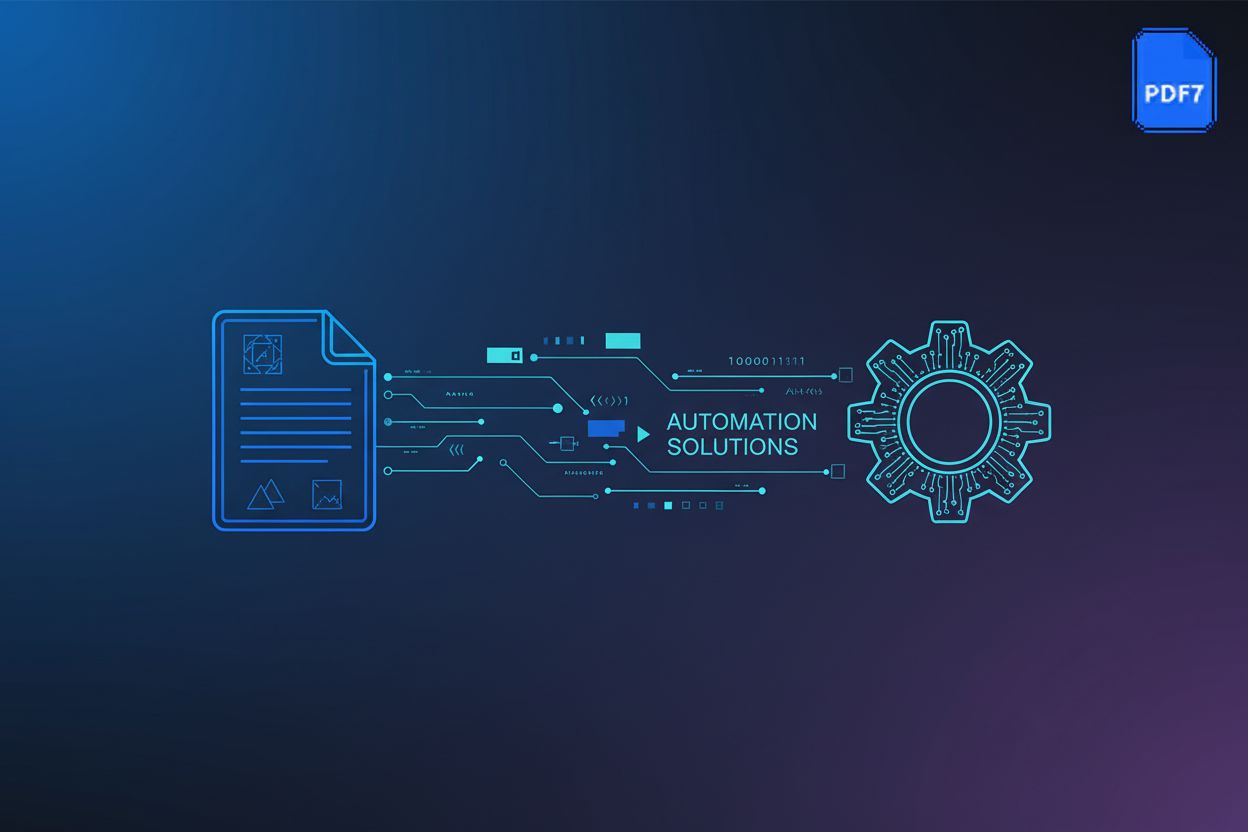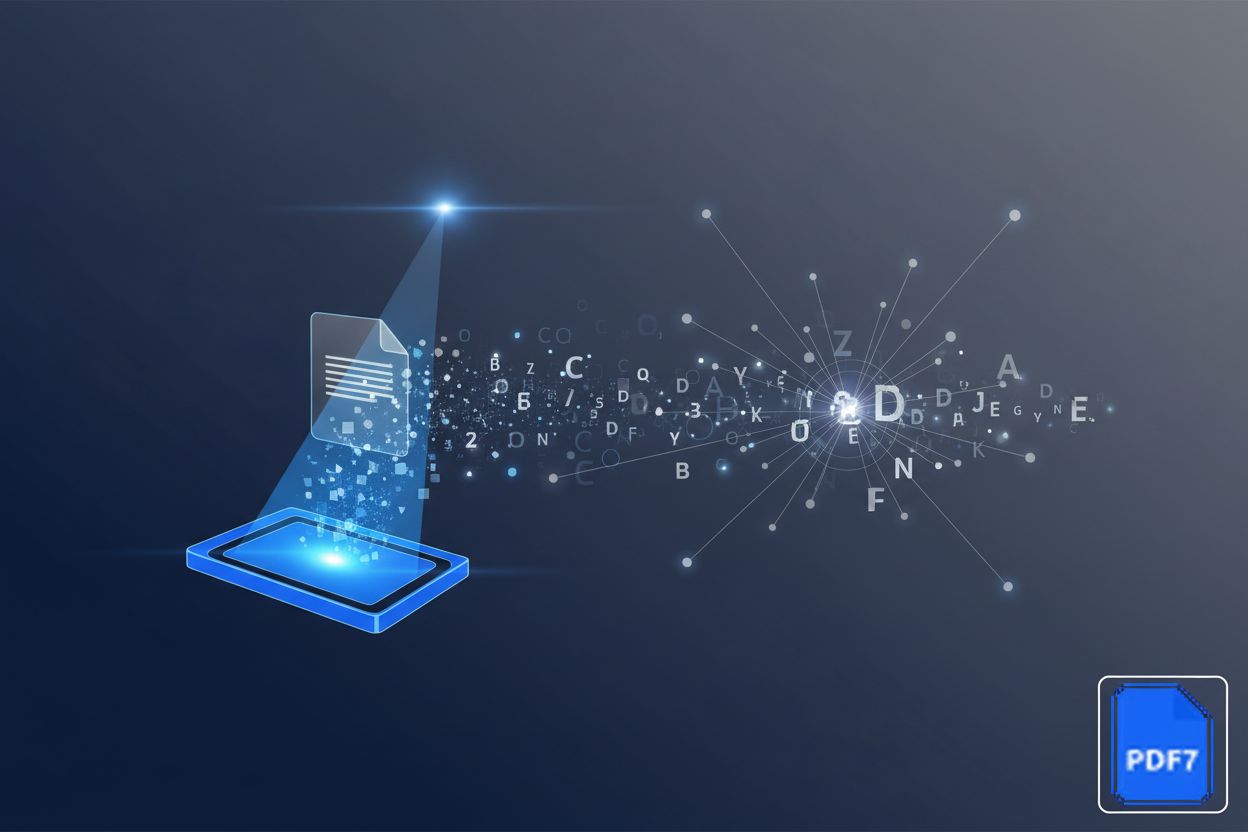Boosting OCR Accuracy: Techniques and Tools for Enhanced Document Processing
Understanding OCR and Its Importance
Did you know that the accuracy of Optical Character Recognition (OCR) can make or break the efficiency of entire business processes? Let's dive into why OCR is so crucial in today's digital world.
OCR is the technology that converts images of text into machine-readable text. Optical character recognition is widely used as a form of data entry from printed paper data records, whether passport documents, invoices, bank statements, computerized receipts, business cards, mail, printed data, or any suitable documentation.
- Data Integrity: High OCR accuracy ensures that the text extracted from documents is a true and reliable representation of the original content.
- Searchability: Accurate OCR results increase the searchability of digital documents, enabling quick information retrieval.
- Workflow Automation: OCR enables automation, such as automatic document indexing and routing, thereby reducing manual intervention and speeding up processing times.
- Compliance: Accurate OCR is important for maintaining compliance in industries with strict regulatory requirements, including audits of legal proceedings and record-keeping.
The OCR engine typically follows a series of steps to ensure accuracy. First, the physical document is scanned, and the image is preprocessed to correct alignment and remove noise. The OCR software then targets one character, word, or text block at a time. This involves pattern recognition, where the engine compares the shapes of characters in the image to known character patterns, and feature extraction, which identifies key characteristics of each character (like curves, lines, and loops). Finally, post-processing techniques, such as spell checkers and ai-based language models, are used to correct errors and increase OCR accuracy. These models analyze the context of words to suggest more probable corrections, going beyond simple dictionary lookups.
While OCR has become integral across industries, achieving high accuracy remains a challenge. According to TDWI in an article from March 2018, relying on page-level accuracy can be misleading if errors cluster in critical data fields. Therefore, field-level accuracy, measured using confidence scores, is essential for data extraction to be reliably integrated into databases or used as metadata.
Many organizations are using OCR to automate data extraction from documents. The New York Times has adapted the OCR technology into a proprietary tool they entitle Document Helper, that enables their interactive news team to accelerate the processing of documents that need to be reviewed.
Understanding the factors that influence OCR performance is the first step toward optimizing its accuracy. In the next section, we'll explore these factors in detail.
Factors Affecting OCR Performance
Did you know that even a slight skew in a scanned document can significantly reduce OCR accuracy? Let's explore the factors that impact how well OCR performs and what can be done to mitigate these challenges.
One of the most significant factors affecting OCR performance is the quality of the original document. According to a hypothetical future article from Octaria, OCR accuracy is negatively affected by documents that are wrinkled, torn, faded, discolored, or smudged.
The quality of the scanned image is equally critical. For example, sharp character borders, high contrast, and good alignment are essential for accurate text recognition. Images with poor resolution, misalignment, or excessive noise can lead to errors.
Font type and size also play a crucial role. OCR software generally performs better with standard, well-defined fonts like Arial or Times New Roman. Similarly, language and character recognition capabilities can present challenges. Multilingual OCR requires software that supports various languages, special characters, and accents. For instance, recognizing characters in complex scripts like Arabic or certain Indic languages, which have ligatures and cursive connections, is far more challenging than recognizing standard Latin alphabets. Even within Latin-based languages, differentiating between similar characters (like 'i' and 'l', or '0' and 'O') can be tricky, especially with unusual fonts or low-quality images.
Advanced algorithms and machine learning can significantly improve accuracy. Using OCR software with updated recognition algorithms and image enhancement tools helps to ensure text clarity. For example, algorithms like Convolutional Neural Networks (CNNs) are adept at learning visual patterns, and Recurrent Neural Networks (RNNs) can process sequential data like text, improving character and word recognition.
For example, in healthcare, patient records often contain handwritten notes. OCR systems must be trained on diverse handwriting samples to accurately digitize this information. The same goes for the retail industry, where invoices and receipts come in various formats and fonts, requiring OCR solutions to adapt to inconsistent layouts.
Understanding these factors is the first step in optimizing OCR processes. Next, we'll dive into preprocessing techniques that can enhance OCR accuracy.
Preprocessing Techniques for OCR Enhancement
Did you know that preprocessing techniques can dramatically improve OCR accuracy, sometimes by as much as 30%? Let's dive into how these techniques work their magic.
Binarization is a crucial first step. It converts grayscale or color images into black and white, which simplifies the image for the OCR engine. This conversion helps to clearly separate the text from the background.
De-skewing corrects any tilt in the scanned document. If the document was not aligned properly when scanned, it may need to be tilted a few degrees clockwise or counterclockwise in order to make lines of text perfectly horizontal or vertical. This ensures that the lines of text are perfectly horizontal or vertical, aiding accurate character recognition.
Denoising removes unwanted artifacts and spots from the image, smoothing the edges of characters. This process helps to eliminate background patterns that can confuse the OCR software.
Layout analysis identifies distinct blocks such as columns, paragraphs, and tables. This is especially important in multi-column layouts and tables, as it helps the OCR engine understand the structure of the document and process text in the correct order.
Script recognition is essential for multilingual documents. The system identifies the script used (e.g., Latin, Cyrillic, Arabic) before applying the appropriate OCR. This involves analyzing the visual characteristics of the characters and their arrangement to determine the language family or specific script. For instance, recognizing whether a document uses a right-to-left script like Arabic or a top-to-bottom script like Chinese is a fundamental step.
For example, consider a financial institution processing handwritten checks. Preprocessing steps such as binarization and denoising enhance the clarity of the numerical values. This reduces errors in amount recognition.
In healthcare, preprocessing helps in accurately digitizing patient records with varying handwriting styles. Incorporating samples of handwritten text improves the model's ability to recognize handwriting.
Effective preprocessing sets the stage for more advanced OCR algorithms. Next, we will explore how advanced algorithms and AI integration are revolutionizing OCR technology.
Advanced OCR Algorithms and AI Integration
Did you know that integrating AI into OCR systems can boost accuracy by up to 30% on poor-quality images? Let's explore how advanced algorithms and AI are revolutionizing OCR technology.
Traditional OCR algorithms rely on pattern recognition and feature extraction. However, these methods often struggle with variations in fonts, image quality, and handwriting styles. Advanced OCR algorithms, enhanced by machine learning (ML) and artificial intelligence (AI), are designed to overcome these limitations.
AI integration brings several key improvements:
- Improved Accuracy: AI-powered OCR systems achieve higher accuracy rates, especially on complex or low-quality documents. According to Octaria, LLM-powered OCR systems can achieve up to 99.56% accuracy for standard documents.
- Contextual Understanding: AI algorithms can analyze the context of the text, which helps in resolving ambiguities and correcting errors. For instance, if the OCR engine encounters the sequence "th_ k", and the surrounding text is about food, an AI model would strongly infer "think" or "thank" rather than a nonsensical word, and if the sentence was "I want to th _k about that," it would likely correct it to "think."
- Better Handwriting Recognition: AI models trained on diverse handwriting samples significantly improve the accuracy of handwriting recognition.
- Multilingual Support: AI-driven OCR can support over 80 languages. Octaria notes that tools like PaddleOCR now support over 80 languages, improving recognition of complex characters. As discussed earlier, multilingual OCR requires software that supports various languages, special characters, and accents.
- Layout Processing: AI can better interpret document layouts, handling complex structures and maintaining formatting.
In the legal sector, AI-enhanced OCR can accurately extract key information from contracts and legal documents, even when dealing with varied formats and handwriting. Financial institutions use these advanced OCR systems to automate the processing of checks and invoices, reducing manual data entry and improving efficiency. The ability to process varied document layouts and handwriting styles is crucial for maintaining accuracy and streamlining operations.
For instance, consider a healthcare provider digitizing patient records. AI-powered OCR can accurately transcribe handwritten doctors' notes. This ensures data is accurately captured and readily accessible.
As we've seen, AI integration significantly enhances OCR capabilities, leading to more accurate and efficient document processing. Next, we'll explore post-processing and verification techniques that further refine OCR accuracy.
Post-Processing and Verification Techniques
Did you know that even with advanced OCR, post-processing techniques can further refine accuracy by up to 15%? Let's explore how these methods ensure the highest quality output from your OCR processes.
One of the most common post-processing techniques is using spell checkers to identify and correct potential errors. These tools compare recognized words against a dictionary, flagging any mismatches. Accuracy can be increased if the output is constrained by a lexicon – a list of words that are allowed to occur in a document.
- Contextual Analysis: Advanced spell checkers also consider the context of the surrounding words to suggest the most appropriate corrections.
- Custom Dictionaries: For specialized documents, custom dictionaries or lexicons can be used to include industry-specific terms and jargon.
Modern OCR systems leverage AI and machine learning to improve error correction. These systems use language models to understand the context of the text and predict the most likely corrections.
- Language Models: AI algorithms are trained on vast amounts of text data to recognize patterns and relationships between words, enabling them to identify and correct errors more effectively.
- Contextual Understanding: As noted earlier, AI can analyze the context of the text, which helps in resolving ambiguities and correcting errors.
While automated post-processing techniques are valuable, manual verification remains crucial for ensuring the highest level of accuracy. This involves human reviewers examining the OCR output and correcting any remaining errors.
- Confidence Scores: Many OCR programs allow users to set "confidence rates". These rates represent the OCR engine's certainty that a particular character or word has been recognized correctly. A high confidence score suggests the engine is very sure about its interpretation, while a low score indicates it's less certain and might require human review.
- Feedback Loops: Corrections made by human reviewers can be fed back into the OCR system to improve future accuracy. This typically involves retraining the OCR model with the corrected data, allowing it to learn from its mistakes and improve its recognition capabilities over time.
Consider a legal firm using OCR to digitize old case files. Spell checkers and AI-powered error correction can help identify and correct common OCR errors, such as misinterpreting "l" as "1" or "o" as "0". Human reviewers then verify the corrected text, ensuring that all data is accurate and complete.
By combining automated and manual verification techniques, organizations can significantly enhance OCR accuracy and ensure the reliability of their digitized documents.
Next, we'll explore how to measure and monitor OCR accuracy to maintain optimal performance.
Measuring and Monitoring OCR Accuracy
Is your OCR as accurate as you think? Measuring and monitoring OCR accuracy is crucial to ensure your digitized documents are reliable and usable.
- Character Error Rate (CER): CER measures the number of character-level errors relative to the total characters. CER calculation is based on the Levenshtein distance concept, which is the minimum number of single-character edits (insertions, deletions, or substitutions) required to change one word into the other. A lower CER means higher accuracy.
- Word Error Rate (WER): WER assesses word-level accuracy, counting the minimum number of word-level operations required to transform the ground truth text into the OCR output.
- Field-Level Accuracy: This measures the correctness of each data field extracted by the OCR system. It is particularly important for structured and semi-structured documents.
- Recall and Precision: Recall measures the proportion of actual positive instances (correctly recognized characters/words) that were correctly identified by the OCR system. Precision measures the proportion of instances identified as positive by the OCR system that were actually correct. Both are vital for understanding performance.
Regularly monitoring OCR performance helps maintain optimal accuracy. A confusion matrix can provide a detailed breakdown of true positives, true negatives, false positives, and false negatives.
Many OCR programs allow users to set "confidence rates".
Processing time and error rate are also important metrics to track. Lower processing times and error rates indicate a more efficient and reliable OCR system.
Consider a healthcare provider digitizing patient records. By monitoring field-level accuracy, they can ensure critical information such as patient names, dates of birth, and medical codes are accurately extracted. This reduces the risk of errors in patient care and billing.
In the financial sector, monitoring OCR accuracy in invoice processing helps prevent discrepancies in payments and financial reporting. Regular audits and performance reviews can identify areas for improvement.
Measuring and monitoring OCR accuracy is an ongoing process. By implementing these practices, organizations can ensure their OCR systems consistently deliver reliable results.
The future of OCR promises even more advanced techniques and tools. Next, we'll explore the trends and innovations shaping the future of OCR technology.
The Future of OCR: Trends and Innovations
The future of OCR is rapidly evolving, driven by advancements in artificial intelligence and machine learning. These innovations promise to enhance accuracy, efficiency, and versatility across various applications.
- AI-Powered OCR: As noted earlier, AI integration brings key improvements, such as better handwriting recognition and multilingual support. LLMs enhance OCR systems by providing contextual understanding and error correction.
- Multilingual OCR: Tools like PaddleOCR now support over 80 languages. Multilingual OCR requires software that supports various languages, special characters, and accents.
- Cloud-Based OCR: Cloud services provide scalable and accessible OCR solutions. OCR was made available online as a service (WebOCR), in a cloud computing environment, and in mobile applications like real-time translation of foreign-language signs on a smartphone.
- Real-Time OCR: Mobile applications and smart devices utilize OCR for real-time translation. OCR is used in internet-connected mobile device applications that extract text captured using the device's camera.
- Specialized Application: OCR engines are being developed into software applications specializing in various subjects such as receipts, invoices, checks, legal billing documents, and even scientific research papers for extracting experimental data.
In the financial sector, advanced OCR systems automate invoice processing. The ability to process varied document layouts and handwriting styles is crucial for maintaining accuracy and streamlining operations.
As OCR technology continues to advance, its integration with AI will drive even greater accuracy and efficiency in document processing. Now that we've explored the future of OCR, let's recap the key steps to boost OCR accuracy.





